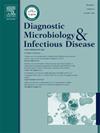Whole genome sequencing characterization of Clostridioides difficile from Bulgaria during the COVID-19 pandemic
IF 2.1
4区 医学
Q3 INFECTIOUS DISEASES
Diagnostic microbiology and infectious disease
Pub Date : 2025-01-18
DOI:10.1016/j.diagmicrobio.2025.116703
引用次数: 0
Abstract
Increased incidence of Clostridioides difficile infections were documented in Bulgarian hospitals during COVID-19. WGS was performed on 39 isolates from seven hospitals during 2015-2022. Antimicrobial resistance and toxin genes were inferred from genomes. MLST profiles, cgMLST, and wgMLST phylogeny analyses were performed. Isolates were grouped into eight MLST types as predominant were ST3 (46.15%) and ST1/RT027 (33.33%). ST3 was detected in a single hospital (16/18) and characterized by two toxin variants: tcdA+/tcdB+ (14) and tcdA-/tcdB+ (4). Twelve ST3 strains belonged to the country-specific cgMLST HC2_6485 cluster and ten were identified as a putative outbreak in the infectious disease ward. All the ST1/RT027 isolates were distributed in six hospitals and clustered in an HC2_4711 with strains from neighbouring countries. All C. difficile were susceptible to vancomycin despite the Thr349Ile mutation in vanS in three isolates. We report the first insights into the C. difficile genotype hospital prevalence during the pandemic.
求助全文
约1分钟内获得全文
求助全文
来源期刊
CiteScore
5.30
自引率
3.40%
发文量
149
审稿时长
56 days
期刊介绍:
Diagnostic Microbiology and Infectious Disease keeps you informed of the latest developments in clinical microbiology and the diagnosis and treatment of infectious diseases. Packed with rigorously peer-reviewed articles and studies in bacteriology, immunology, immunoserology, infectious diseases, mycology, parasitology, and virology, the journal examines new procedures, unusual cases, controversial issues, and important new literature. Diagnostic Microbiology and Infectious Disease distinguished independent editorial board, consisting of experts from many medical specialties, ensures you extensive and authoritative coverage.

 求助内容:
求助内容: 应助结果提醒方式:
应助结果提醒方式:


